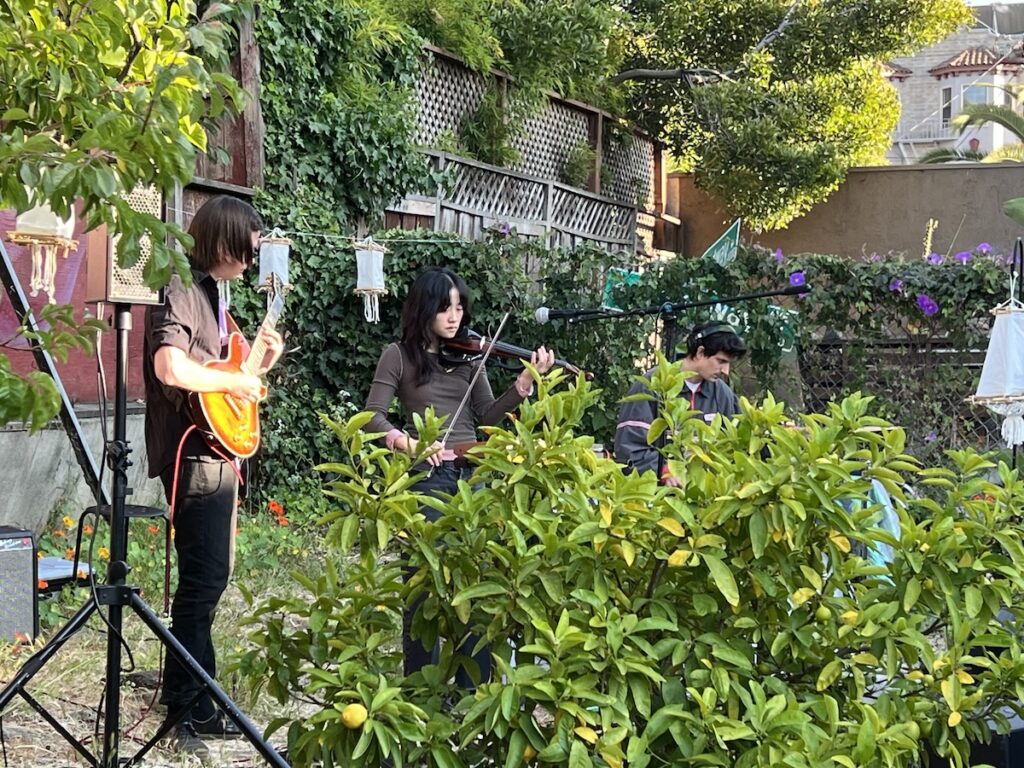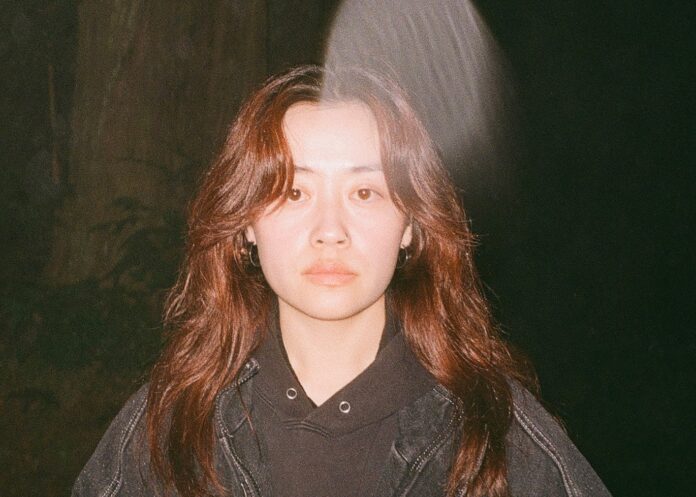A few months after moving to San Francisco, I went to see a show at the Knockout featuring the local weird-punk band Juicebumps. I was impressed by the band’s nervy energy and the way their songs often took sharp, surprising melodic turns, simultaneously brash and precise.
So when I listened to “heat resonance,” the first single from Juicebumps bassist Shaina Pan’s debut EP as sachi’s mirror, I was startled. The song is a creeping, ephemeral ambient-pop track that layers metallic violin textures and iridescent synths beneath Pan’s yearning vocal; if Juicebumps’ music calls to mind angular ’80s bands like Devo or harsh contemporary acts like Model/Actriz, Pan’s work as sachi’s mirror feels closer to artists like Kate Bush, Sudan Archives, or Rachika Nayar, leaning into languorous melodies and clever sonic manipulation.
Pan’s EP, room to receive, is out now via the Oakland-based label Cone Shape Top; over email, she says that the EP was inspired by nature and mythology, and that each of its songs uses field recordings as “portals” to specific emotional memories. I wanted to learn more about how the EP’s sound came together, so shortly before the EP’s release, we spoke over Zoom about Pan’s musical journey, the improvisational process behind sachi’s mirror, and learning to trust your instincts.
48 HILLS I wanted to start off with a pretty broad question. One of the things that caught my attention was your musical journey leading up to this project. How did you arrive at this particular sound for sachi’s mirror, versus the other work that you’ve done?
SHAINA PAN It’s rooted in growing up in classical music. I started playing violin when I was quite young, and I didn’t take it very seriously for a long time. It was initially very frustrating, being six years old and just making screech sounds on the violin, so it took me a while to actually feel like it was something I enjoyed and was good at. In that way, music has always been a big part of my life, and especially the collaborative aspect of it, playing in youth orchestras. Part of the reason why I went on to study it in school was because it was more about connecting with others through music and creating a shared sound together, in an ensemble.
Those are all reasons why I still play music today, but it’s evolved quite a bit. The pandemic was a big turning point for me. I had a lot of time to think on my approach as a musician and as a creative person. I had just graduated with my masters in violin performance, and I moved to upstate New York and lived in this very isolated village for a year. And I was playing in this orchestra, but since it was the pandemic, there weren’t any live events with audiences, everyone was very separate onstage, there weren’t any real concerts or anything like that. I think that was a turning point of realizing, “Maybe it’s time to recalibrate what it is I’m doing with my life. This doesn’t feel like it’s mine anymore.”
So I eventually moved back to the Bay, and I moved in with my partner. He plays in post-punk band Juicebumps. At the time, the bassist in that band had just decided that he was moving to Portland, so we had a conversation like, “Do you wanna try it out just to see how it goes?” And I was like, “Yeah, fuck it.” My partner recorded a bunch of Youtube tutorials of how to play the basslines, and I watched them a million times and figured it out—not knowing anything about how to play bass or the music theory behind it, but just copying where the fingers went. I had always enjoyed listening to non-classical music, but this was one of the first times I got to perform and eventually write [that kind of] music. And songwriting never really crossed my mind before as a classical musician, who mostly played other peoples’ music, mostly dead European composers’ music. I started to write my own music because I started to feel a little more comfortable trying those things out after collaborating in writing aspects of Juicebumps.
48 HILLS I’ve seen Juicebumps play, so that was one of the things that I thought was really interesting—listening to “heat resonance” and the single you released earlier in the year as sachi’s mirror [“coral miracle church”], hearing how different the sounds were. Hearing also that you do some of the writing for Juicebumps as well, do you have ideas for lyrics or melodies or sonic textures that you’re like, this could go to Juicebumps, this could go to sachi’s mirror, this could go to some other place? Or is it more improvisational?
SHAINA PAN In my mind, they’re pretty separate sonically. For Juicebumps, I feel like I’m in more of a supportive role. The sonic world is already there, so I’m trying to fit into that world with whatever tools or ideas I have. Whereas with sachi’s mirror, it feels wholly my own. With that sonic world, I lead with a more improvisational approach, with violin or string textures. And specifically, I lean towards more experimental or extended technique textures, which are taken from back when I was more involved in the classical world. I played a lot of contemporary classical music—playing music by living composers and helping them bring their work to life. That typically involved more forward-thinking ways of playing the instrument, not always aiming to create the most perfect or beautiful tone. I found that really freeing, and I try to incorporate that approach into sachi’s mirror.

48 HILLS Could you give an example of something like that? I’m curious to hear more about getting nontraditional or different textures from the violin.
SHAINA PAN On a technical level, there’s kind of a sweet spot when you’re playing the instrument—where you place the bow on the string, the speed, the way you use vibrato in your left hand. That would be the standard, classical violin sound. With more experimental techniques, you’re using the bow in unconventional ways. Maybe you’re putting it closer to the bridge which creates a more metallic, scratchier sound, or you’re putting it further away from the bridge in the opposite direction, which makes a more subdued, fuzzy sound. There’s a lot of technical things you can do with the instrument to create unexpected or unconventional sounds that might not even sound like the violin as we traditionally think of it. Experimenting with that is really fun.
On this EP, there’s a lot of moments like that. On the first track, I ricochet the bow on the string and it creates this bouncy texture. There’s another track, like on “heat resonance,” where I put the bow really close to the bridge so it does create that hissing, metallic sound. Messing around with those sounds is something that I really enjoyed in the writing process, arriving at that sound world and incorporating it into the synth or field recordings.
48 HILLS I’m curious what it is about those more experimental techniques that draws you to using them.
SHAINA PAN For me, it feels kind of subversive, because of my background. Even when I was still in school and doing mostly classical music, I’ve always been drawn to figuring out how I can approach something with a different lens. How can I make something my own? It’s kind of about finding my own language. Because a lot of times, in that world, it is very traditionalist. Certain composers, they’re like gods. The culture is very much about doing things a very particular way and a very rigid way. I think that finding my own language in that world was really important to me, and really empowering in many ways.
48 HILLS It’s interesting hearing that. One of the things that I was interested in when I was listening to “heat resonance” and “coral miracle church” is that it does feel very freeform, and moving in a bunch of different directions all at the same time, which feels of a piece with what you’re saying. It doesn’t feel locked into anything. Is that something you intentionally set out to explore in your solo work, or is that something that came up through the process of making it?
SHAINA PAN It’s definitely something that I feel intentional about exploring. Something that I found myself doing when I was writing was—not coming from a super-improvisatory background—I would create loops, or small chunks of time where I would do whatever I wanted. But it was just four or eight bars, so it didn’t feel like I [had] to free improv for like 10 minutes, because that can feel very daunting to me. That was a big part of the writing process. Whatever came out, I would embrace that and integrate it in some way into the song.

48 HILLS I’m curious about how you might see the project evolving moving forward too, and how you see this as a piece of your larger musical work.
SHAINA PAN It feels very early stages right now. Even though I’ve played music for a long time, writing music is a whole different thing, and it feels very vulnerable. There’s a lot of mental gymnastics to be like, “OK, this is fine, I can share this with the world and it’s not a big deal.” Looking forward, I know that I want to continue with a similar writing approach—keeping things pretty freeform and trusting my intuition. I’m generally pretty perfectionist as a result of being conditioned to be a perfectionist. I think it takes a lot to unlearn those things. So that’s a big part of it, continuing to lead with instinct and curiosity.
I’ve started writing an album and I’m in the process of putting together demos. This last EP is very much a solo effort. I recorded, mixed everything myself, so it’s a bit more lo-fi. And for the album that I’m working on now, I’d like to see if I can record it for real, in a studio. But yeah, other than that, just continuing to trust myself and lead with curiosity.
48 HILLS It’s interesting hearing that it was done on your own, especially thinking about what you said earlier about music as a community, collective endeavor. Was that a purposeful decision you made when you started making the EP, or was that something that arose out of just wanting to get it out there?
SHAINA PAN Feeling so new to the whole songwriting process, I wanted to take the time and space to myself to just incubate, and to figure things out on my own before bringing in other voices or approaches. It felt like I was in this little shell for a while figuring things out, and building some level of confidence in being able to do that. But I still feel like collaboration is one of the most enjoyable things about music, and it’s something I might prioritize a little bit more this next time around.
48 HILLS I’m interested to see how that changes the sound. One of the things that drew me to the music is that the composition and the way the musical textures feel, it does feel very coherent. If you bring in other instruments or other people, it affects how everything ends up feeling.
SHAINA PAN Yeah, me too. It definitely complicates things playing with multiple people, as I’ve learned playing in a band. But even in collaboration, it feels like there’s always tiers of involvement, and I feel like there’s a way to collaborate while still guiding everyone and towards one person’s vision. Or bringing someone in and eventually working towards a shared vision. But there’s always roots, or a thread from which everything comes from.
48 HILLS Hearing about you developing your songwriting voice, I was curious what that process has taught you about how you approach songwriting, and on the broader level, what it’s taught you about yourself?
SHAINA PAN I mean, it’s definitely taught me a lot about myself [laughs]. But the first part was how this whole process, or what it’s taught me about songwriting?
48 HILLS Yeah, or how you approach songwriting. If you step back and think, oh, this is the kind of thing that I do naturally if I’m being tasked with writing a song.
SHAINA PAN Building off a bit of what I was talking about earlier, with instinct: I’ve gotten to points with certain songs where I redid the same thing so many times that I can’t even recognize what I’m trying to accomplish with it. I think that comes from many years of practicing the same piece for hours and hours every day, or recording audition tapes where you do 30 or 40 takes of the same thing until it’s just right. But then you’re like, “No, the first or second take was the best one.” I think that lesson extends to songwriting as well. It’s a bit of the first thought, best thought mentality, and just accepting what it is. There’s always what you think it could be, or whatever best version in your head, but it’s made up. It doesn’t exist. It’s a lesson to just be in the moment when you’re undergoing that whole process. Because if you go through the process of trying to get it perfect, or that perfect version, I think it can be pretty destructive creatively.
And I think that ties into what I’ve learned about myself. It has a lot to do with self-acceptance and self-trust. I think that those are things that are not necessarily valued in our society, where maybe it’s more advantageous to certain systems of power to hate yourself or to feel like you’re not good enough, to have that scarcity mindset. But it’s okay to have this thing right now for yourself.
Get room to receive by sachi’s mirror here.





